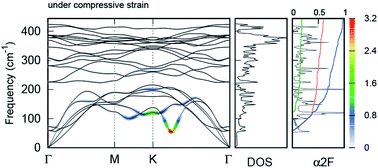Straintronic effect for superconductivity enhancement in Li-intercalated bilayer MoS2†
Abstract
In this study, ab initio calculations were performed to show that the superconductivity in Li-intercalated bilayer MoS2 could be enhanced by applying either compressive or tensile strain. Moreover, the mechanism for superconductivity enhancement for the tensile strain case was found to be different than that of the compressive strain case. Enhanced electron phonon coupling (EPC) under tensile strain could be explained by an increase in the nesting function involved with the change in the Fermi surface topology in a wide range of Brillouin zones. The superconducting transition temperature Tc of 0.46 K at zero strain increased up to 9.12 K under a 6.0% tensile strain. Meanwhile, the enhancement in compressive strain was attributed to the increase in intrinsic electron phonon matrix elements. Furthermore, the contribution from interband scattering was large, which suggested the importance of electron pockets on the Fermi surface. Finally, 80% of the total EPC (λ = 0.98) originated from these pockets and the estimated Tc was 13.50 K.

- This article is part of the themed collection: Welcome to the community


 Please wait while we load your content...
Please wait while we load your content...